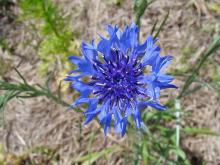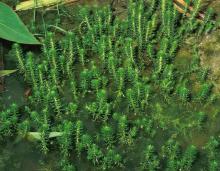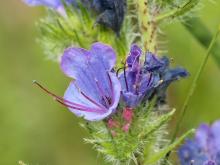Wildflowers, Grasses and Other Nonwoody Plants
Media

Species Types
Scientific Name
Viola sororia
Description
The common violet can be violet, white, or white with violet mottling or spots. One of 17 species or violets in Missouri, it occurs statewide in a variety of habitats. Note its heart-shaped or rounded, scalloped leaves, and (usually) the presence of hairs on stems and/or foliage.
Media
Species Types
Scientific Name
Vernonia baldwinii
Description
Ironweeds are tough, grayish-green, branching plants known for their fluffy-looking clusters of reddish-purple florets. They are a familiar sight on roadsides and pastures. Identify western ironweed by the bracts at the base of the flowerheads.
Media

Species Types
Scientific Name
Carduus nutans
Description
An invasive native of Eurasia that is spreading in Missouri, musk thistle is a plant you should know. Learn how to tell the difference between our native thistles and these bad guys.
Media

Species Types
Scientific Name
Lespedeza virginica
Description
A bushy native perennial legume with small clusters of pink flowers, slender bush clover provides nectar for numerous insects. Several types of birds eat the seeds, and many mammals eat the foliage.
Media

Species Types
Scientific Name
Centaurea cyanus
Description
A native of Europe, cornflower is a popular garden flower that often escapes to nearby areas. It’s used in bridal bouquets and men’s boutonnieres. Its intense blue color appears in boxes of crayons!
Media

Species Types
Scientific Name
Vicia villosa
Description
Branching, spreading, and tangling, hairy vetch forms dense colonies along highways and other disturbed sites. This softly hairy ground-covering plant has one-sided clusters of purple pea flowers.
Media

Species Types
Scientific Name
Myriophyllum spp.
Description
Water milfoils are feathery aquatic plants that grow rooted in shallow water. Their tips emerge above the waterline and bear bladelike, toothed leaves.
Media

Species Types
Scientific Name
Commelina communis
Description
The flowers of dayflower are truly blue, and they have only two conspicuous petals. A fast-growing, sprawling, but shallow-rooted weed, this introduced species commonly annoys gardeners.
Media

Species Types
Scientific Name
Datura stramonium
Description
Pretty but poisonous, jimsonweed has white goblet-shaped flowers that open around midnight. This native of tropical America was introduced nearly throughout the United States and thrives in disturbed soils.
Media

Species Types
Scientific Name
Echium vulgare
Description
A biennial plant with bristly hairs and usually with single stems, viper’s bugloss can grow 2½ feet tall. The flowers are pink in bud, blue to ultramarine later. The protruding stamens are pink.
See Also
About Wildflowers, Grasses and Other Nonwoody Plants in Missouri
A very simple way of thinking about the green world is to divide the vascular plants into two groups: woody and nonwoody (or herbaceous). But this is an artificial division; many plant families include some species that are woody and some that are not. The diversity of nonwoody vascular plants is staggering! Think of all the ferns, grasses, sedges, lilies, peas, sunflowers, nightshades, milkweeds, mustards, mints, and mallows — weeds and wildflowers — and many more!





















